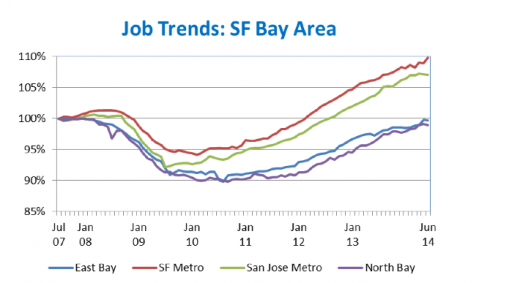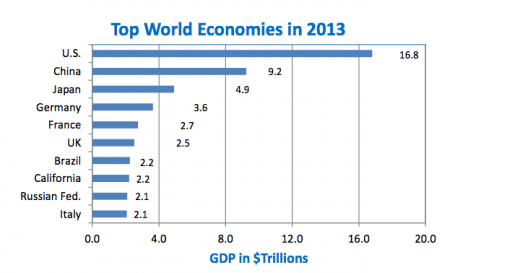By most accounts, our state and region are booming. This is welcome news after several years of a sluggish economy and a major recession. California is growing faster than the country and other global powers. The state is now the world’s eighth largest economy (after dropping from fifth largest to 10th between 2002 and 2012). The Bay Area has increased its national share of venture capital funding, an important feedstock for the next round of start-ups.
Despite the generally good economic news, challenges remain. Housing costs are out of reach for many, some parts of the Bay Area still haven’t returned to their pre-recession job levels, unemployment remains stubbornly high in a few places and there are too few middle-wage jobs.
Below are some highlights for the region and state according to several new sources of economic data analyzed by Steve Levy at the Center for Continuing Study of the California Economy.
Key findings about the Bay Area:
- The nine-county Bay Area added nearly 103,000 jobs in the past year, a gain of about 3 percent. This is more than Los Angeles County (96,000) even though LA County has just under 10 million people and the Bay Area about 7.4 million.
- The Bay Area now has 5 percent more jobs than before the recession began in July of 2007, the best recovery of any region in the state. San Diego is a few percentage points above pre-recession levels, and the San Joaquin Valley just returned to pre-recession levels.
- Within the Bay Area, San Francisco, San Mateo and Santa Clara counties are leading the recovery, with the SF Metro Area (San Francisco, San Mateo and Marin counties) at about ten percent above pre-recession peak employment and Santa Clara County about seven percent above.
- Not all parts of the region are booming equally. While growing, the North Bay and East Bay have yet to return to the pre-recession employment levels. Both areas were more heavily impact by the housing crash and are not experiencing as much growth in tech jobs.

The rate of employment is now above the 2007 peak in both the San Francisco and San Jose metro areas, but it remains below pre-recession levels in the East Bay and North Bay. Source: Center for Continuing Study of the California Economy.
- In global comparisons, the Bay Area’s $630 billion total economy is just smaller than Switzerland’s, which is $651 billion. That would make the Bay Area – if it were its own nation— the world’s 21st largest economy. On a per capita basis, the Bay Area’s economy is slightly ahead of wealthy Switzerland’s.
- In contrast, the Los Angeles Basin (a five-county region) has a $995 billion economy that would be the globe’s 16th largest, behind Mexico’s $1.25 trillion economy. Yet Mexico’s population is 122 million and the LA Basin’s just 18.3 million. This means that on a per capita basis, the LA Basin is more than six times as wealthy as Mexico.
Key findings about California:
- California’s more than $2.2 trillion economy would rank eighth globally were California its own country. Between 2012 and 2013, California’s economy grew by $200 billion to push the state past Russia and Italy and close in on Brazil, in seventh place.
- Between 2000 and 2002, California had the world’s fifth largest economy. (State economic data is available at the Department of Finance website). In 2003, California’s economic ranking dropped to seventh when it was passed by France and Italy. But in that year, California’s economy remained just larger than China’s (and far larger than Brazil and Russia — then ranked 16th and 17th, respectively). Times have changed: China’s economy now ranks second in the world, and Brazil ranks seventh. Soon, California’s economy is likely to be passed by India (which now ranks just after Italy).

California has the eighth largest economy in the world. Source: Center for Continuing Study of the California Economy.
- California has added 1.4 million jobs since December of 2009 and is growing faster than the nation as a whole. California’s job base has grown by 9.6 percent since December 2009 and the nation as a whole by 7 percent.
- In the past year, key growth industries in California include information services, which includes Internet and motion picture jobs (up 5.1 percent), construction (up 4.7 percent), education and health services (up 4.5 percent) and professional and business services (up 4 percent).
- Unemployment is down to 7.4 percent from a high of 12.4 percent but remains above the national rate.
Overall, the news is good and economic growth will likely continue for some time. Yet there’s still ground to make up in parts of our region that are not booming as much as San Francisco, San Mateo and Santa Clara counties. Our long-term growth prospects remain connected to major issues we have some control over (like the development of housing) and others we have less control over (like immigration policy and federal investment in infrastructure). Stay tuned this fall for SPUR’s upcoming report on economic prosperity, which will explore local and regional strategies to address one piece of the employment puzzle: increasing upward mobility.
